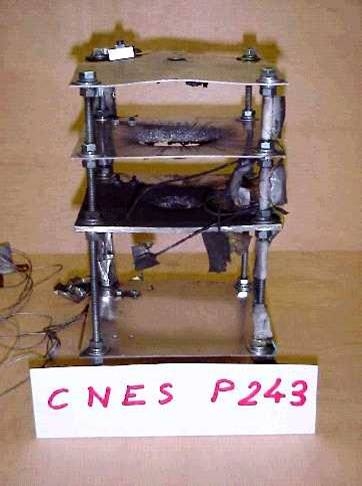Risks
In orbit
In orbit, objects have relative velocities of up to 15 to 20 km/s. At these speeds, the kinetic energy of a particle, no matter how small, is considerable: at present, no shielding can withstand objects larger than 1 or 2 cm, while the spacesuit of an astronaut on EVA is even more fragile.
The following table indicates the thickness of an aluminium wall that an aluminium ball of a given size can perforate at a velocity of 10 km/s:
| Projectile Diameter | 0.01 mm | 0.1 mm | 1 mm | 10 mm |
| Thickness perforated | 0.03 mm | 0.4 mm | 4 mm | 50 mm |
Table 1 - Thickness of aluminium perforated according to the size of the projectile


Figure 1 -
Hyper Velocity Impact Test sample - Damage created by a spherical aluminium particle of 1mm in diameter at 10 Km/s
The probability of impact depends on the time spent in orbit, the surface area of the vehicle and the characteristics of its orbit.
For example, the following table gives the probability of collision with particles of a given size over a period of one year:
| - | > 0,1mm | > 1mm | > 1cm | > 10cm |
| Station Spatiale (h=400Km, S=500m2) | 1 | 9,33E-01 | 2,21E-02 | 7,17E-04 |
| Spot (h=800Km, S=20m2) | 1 | 2,46E-01 | 5,53E-03 | 2,76E-04 |
| Constellation (h=1500Km, S=16m2) | 1 | 1,10E-01 | 1,70E-03 | 7,76E-05 |
| GEO (h=36000Km, S=30m2) | 1 | 1,49E-03 | 9,39E-06 | 3,31E-07 |
Table 2 - Annual probability of collision according to the size of the projectile
In 1996, the first known collision in Space was observed between an operational satellite and a piece of debris: according to the identification provided by the United States, a piece of debris from the 1986 explosion of an Ariane 3rd stage struck and damaged the French Cerise satellite.

Figure 2 - Cerise collision with a piece of debris (artist’s impression)
It is most likely that this type of event will occur with increasing frequency. The corresponding risk is taken into account for flights by the American Space Shuttle: collisions with small objects have led to more than 60 windows being replaced since the beginning of operations and avoidance manoeuvres have been carried out on several occasions to avoid a collision with larger objects. Today, objects measuring between 1 and 10 cm represent the greatest threat. The shielding is unable to stop them and they cannot be avoided because they are too small to be tracked from the ground.
On the ground
On the ground, the risk comes from potential falling objects in the event of atmospheric re-entry. During re-entry into the atmosphere, owing to their very high speed, vehicles are subjected to mechanical and thermal stresses leading to their fragmentation and the melting of most of the materials. However, certain materials such as steel, titanium and composites can withstand these stresses well and some items can reach the ground. If re-entry is uncontrolled (natural re-entry owing to orbital decay), it is very difficult to predict where the object will fall and the size of the objects which represent a potential danger. The lack of precision stems mostly from a lack of understanding of the atmosphere and the difficulty involved in modelling the attitude movements of the vehicles (stable equilibrium position or complex rotation movement for example). In 1979, the re-entry of the American Skylab laboratory led to about 20 metric tons of debris falling over several thousand km along the trajectory (Indian Ocean and Australia). Similarly, re-entry by Salyut 7 in 1991 led to debris falling in South America.
| - | Perigee x Apogee [Km] | Approximated Lifetime |
| Space Station Like Orbit | 400 x 400 | 6 Months – 1 Year |
| Spot like Orbit | 825 x 825 | 200 Years |
| GEO Transfer Orbit | 200 x 36000 | 10 Years |
| GEO Transfer Orbit | 600 x 36000 | 10000 Years |
| GEO | 36000 x 36000 | Millions of Years |
Tableau 3
Approximate lifetime of space debris according to the perigee and apogee of their orbit